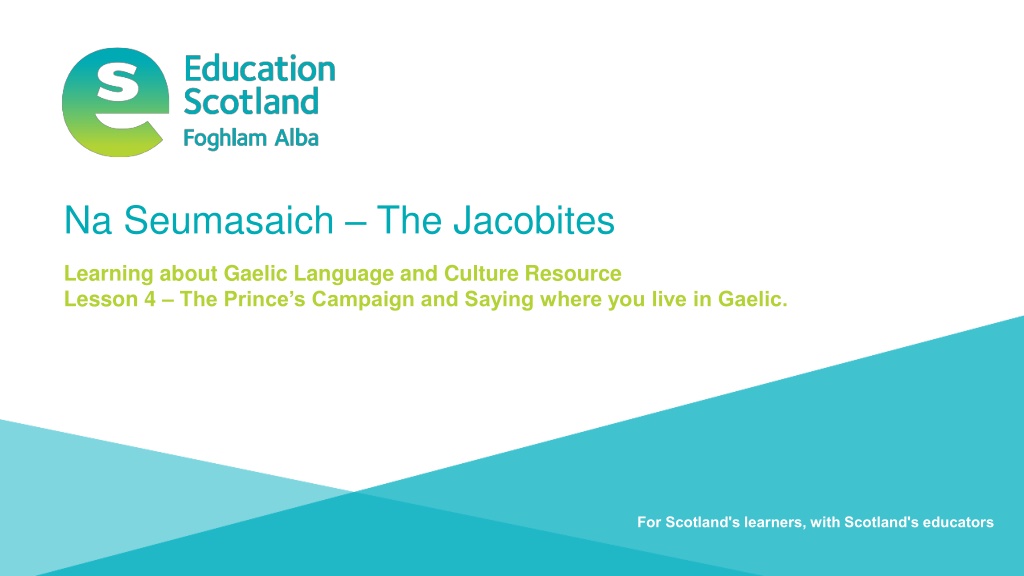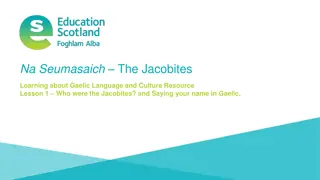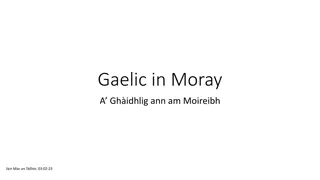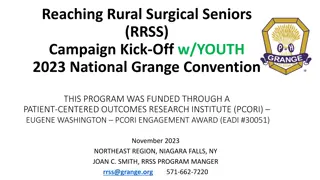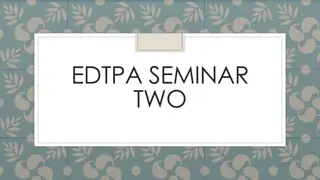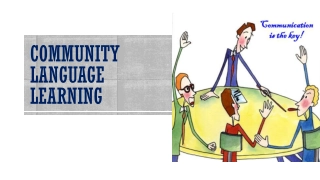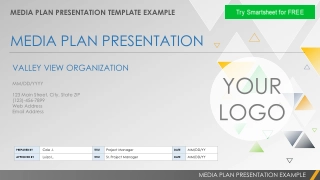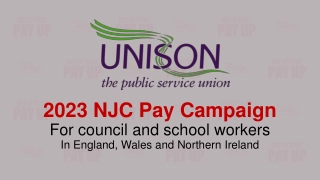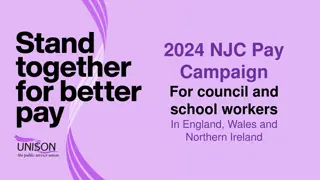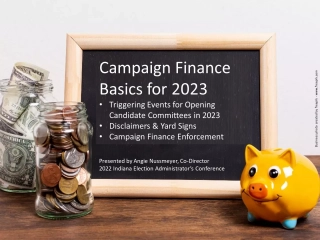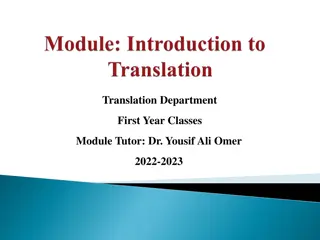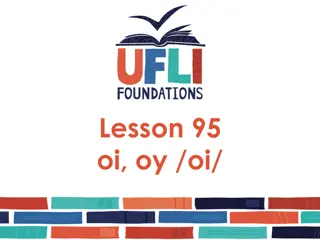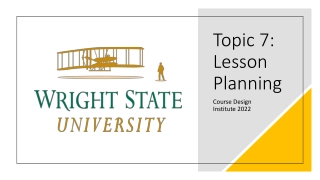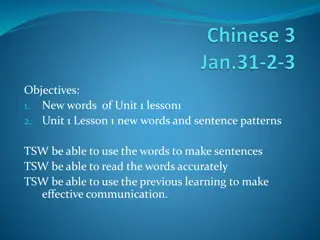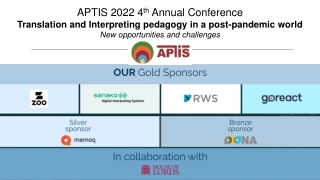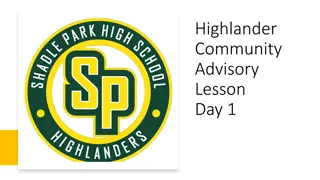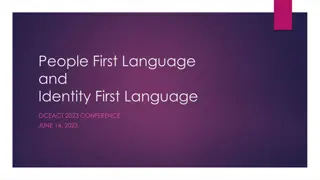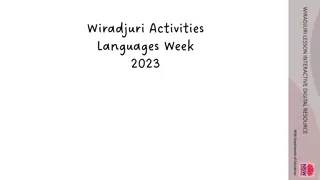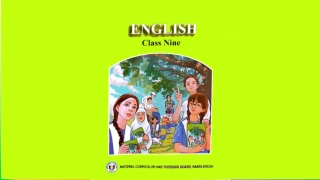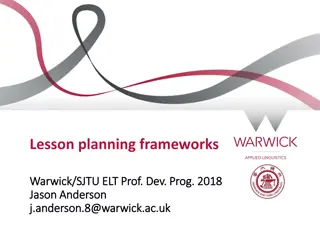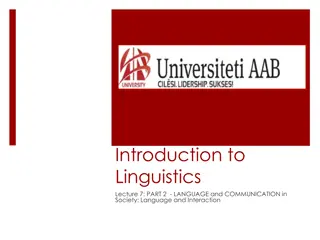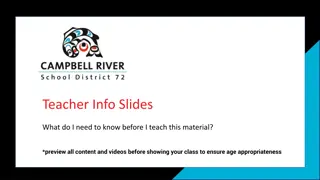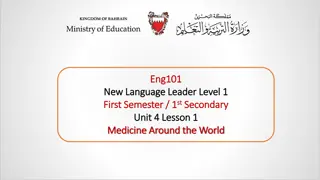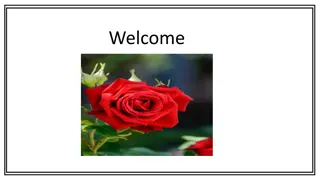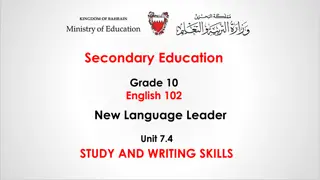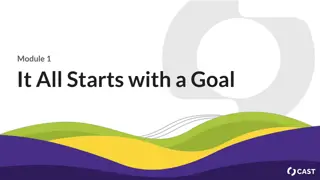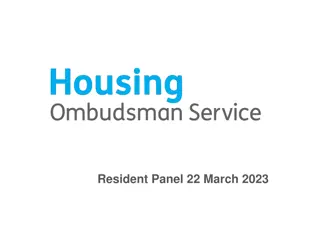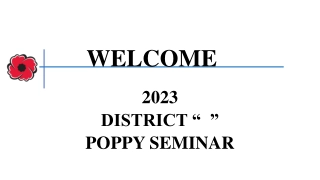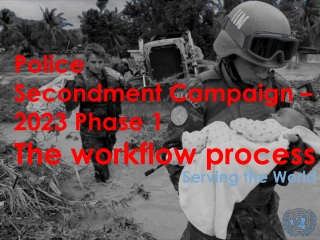Learning about Gaelic Language and Culture: Lesson 4 - The Prince's Campaign
Discover the historical journey of the Jacobites in Lesson 4 of Learning about Gaelic Language and Culture. From the Battle of Prestonpans to understanding Gaelic placenames, explore key aspects of Gaelic heritage and language in Scotland.
Learning about Gaelic Language and Culture: Lesson 4 - The Prince's Campaign
PowerPoint presentation about 'Learning about Gaelic Language and Culture: Lesson 4 - The Prince's Campaign'. This presentation describes the topic on Discover the historical journey of the Jacobites in Lesson 4 of Learning about Gaelic Language and Culture. From the Battle of Prestonpans to understanding Gaelic placenames, explore key aspects of Gaelic heritage and language in Scotland.. Download this presentation absolutely free.
Presentation Transcript
Na Seumasaich The Jacobites Learning about Gaelic Language and Culture Resource Lesson 4 The Prince s Campaign and Saying where you live in Gaelic. For Scotland's learners, with Scotland's educators
Na Seumasaich Lesson 4 In this Learning about Gaelic Language and Culture resource lesson we will learn: about the Battle of Prestonpans about a famous Jacobite woman, Jean Camerson of Glendessary to say where we stay/live in Gaelic to ask someone where they stay/live in Gaelic to understand how to say this in contexts about some Gaelic placenames for towns and areas about the clan system in the Highlands of Scotland to create short texts about ourselves and others in Gaelic
Miri and Calum F ilte air ais a Chaluim Welcome back. Tapadh leat a Mh iri C it a bheil thu a fuireach? Tha mi a fuireach ann an Loch Abar
So the Prince has landed in Glenfinnan. Yes, he marched east through the Corriyairack Pass towards Perth. There more people joined him. They then took over Falkirk. Why did the British Government not stop him? Sir John Cope, the head of the British army, had taken his troops to Inverness and had let the South undefended. Oh dear! That was a bit silly!
Cit an deach na Seumasach? Where did the Jacobites go? The Prince raised his army first in Glenfinnan (Gleann Fhionnain) in Lochaber (Loch Abair). The then marched east through the Coireyirack Pass (Coire Ghearraig), where there was a military road. Follow the red line on the map. InbhirNis They raised more soldiers in Perth (Peairt) then headed to Falkirk (An Eaglais Bhreac) before entering Edinburgh (D n ideann). ObarDheathain They had managed to avoid the British Army who had gone to Inverness (Inbhir Nis) and had to jump boats in Aberdeen (Obar Dheathain) to sail South to catch the Prince. Follow the blue line on the map. Coire Ghearraig Peairt GleannFhionnain Baile an t-Sagairt They would finally meet at Prestonpans. (Baile an t- Sagairt) in a famous battle. An Eaglais Bhreac Creative Commons Attribution-ShareAlike 3.0 Unported CC BY-SA 3.0 MrPenguin20
Cit an deach na Seumasach? Where did the Jacobites go? - Questions Q1 Use a blank map of Scotland and mark the places the Prince and his Jacobite Army went. Write the names in Gaelic and English. Q2 Now add on the places where the British Army went using a different colour. Q3 Now add the place that you live and find out the Gaelic for it as well.
What happened when they reached Edinburgh? The Prince entered Edinburgh with 2400 men. His father was declared King, but they did not take Edinburgh Castle. What about Sir John Cope? He led his troops to an embarrassing defeat at Prestonpans near Edinburgh. The Highland Charge and inexperienced British Troops meant the Jacobites won in 30 minutes! Wow! That is embarrassing. Next stop, England!
The Battle of Prestonpans On the 21st of September, the first major battle of the 1745 Rebellion took place at Prestonpans to the east of Edinburgh. Sir John Cope led the British troops. He was very confident his 2000 troops would beat the poorly armed Jacobites. He positioned them in behind a piece of marshy ground to the South but the Jacobites found a way through to the East thanks to a local farmer in the early hours of the morning. Despite an argument between Prince Charlie and his general George Murray, the Highland Charge again won the day. The British Dragoons fled in terror and between 300-500 British soldiers were killed, and 500-600 captured. 450 soldiers under Cope reached Berwick upon Tweed the next day. CC BY-SA 3.0 - Hoodinski
CC BY-SA 3.0 - Hoodinski The Battle of Prestonpans Questions Q1 What day did the Battle of Prestonpans happen? Q2 Why would Sir John Cope feel confident? Q3 What shows that not everything was good in the Jacobite camp? Q4 Many of the troops the Jacobites took prisoner were released can you think why this might be?* A - It would have been expensive to feed them! B - The Jacobites felt sorry for them C They all agreed to fight for the Prince CC BY-SA 2.0 Renata Edge
Hey! Johnnie Cope! Sir John Cope s reputation never recovered from the loss at Prestonpans. A court-martial found him not guilty, and blamed a poor quality of soldier. However, the story of his defeat has become a legend. Mostly as he was the subject of a Scots language song called Hey hey Johnnie Cope, Are ye waukin yet? You could learn to sing the chorus of this song in Scots. Hey! Johnnie Cope are ye waukin' yet? Or are your drums a-beating yet? If ye were waukin' I wad wait, Tae gang tae the coals in the morning. Hey Johnnie Cope (scotslanguage.com) 14 - Johnny Cope - YouTube CC BY-SA 3.0 - Hoodinski
Jean Cameron of Glendessary Wow! This woman looks cool! C i? D an t-ainm a th oirre? Seo S ne Chamshron. She is a one of the most famous Jacobite women, and she has a very interesting story.
Tha mi a fuireach ann an Loch Abar Jean Cameron of Glendessary 1 Jean Cameron was a member of the Clan Cameron. She looked after her brother s land in Lochaber. When Bonnie Prince Charlie landed at Glenfinnan, she raised over 200 men to go fight. This was a scandal as many people did not believe a woman could do such things at the time. The British press and the public spread nasty rumours that Jean travelled with the Prince, and that they were even in love. She was sometimes called The First Lady of the Forty-Five However, evidence suggests that Jean may never even have left home or even spoken to the Prince. However, this didn t stop Jean or Jenny as she also was known becoming an infamous character who even had the cheek to wear tartan trousers! A British propaganda sheet showing Jenny as a soldier in trousers.
Tha mi a fuireach ann an Loch Abar Jean Cameron of Glendessary 1 Questions 1.How many men did Jean Cameron raise for the Prince? 2.Why was this a scandal at the time? 3.Name at least two rumours that were made up about Jean Cameron. A British propaganda sheet showing Jenny as a soldier in trousers.
Jean Cameron of Glendessary 2 In the years after the 45 rebellion, with the Highlands raided and under army rule, Jean felt sad and left to start a new life in the Lowlands. Jean made her home at farm called Blacklaw House where the town of East Kilbride (Cille Bhr ghde an Ear) is built today. Many Jacobites and other Highlanders would visit her there. It became known as Mount Cameron. Even though the house was demolished in 1958, this area is still called Mount Cameron after her and many of the streets around it are named after areas of Lochaber. There is a cairn and a chestnut tree marking her grave on a street called Glen Dessary. The local Mount Cameron Primary School has a Gaelic medium unit. Many of the children receive all their education in Gaelic, the language Jean would have spoken. Tha mi a fuireach ann an Cille Bhr ghde an Ear Photo of Blacklaw House, East Kilbride from Old Photographs, Bill Niven, 2016
Jean Cameron of Glendessary 2 Questions 1. Why did Jean move to the Lowlands? 2. Where did she move to, and what is it called today? 3. What marks the place where she is buried? Tha mi a fuireach ann an Cille Bhr ghde an Ear 4. What other special connection does the area have to Jean to this day? Photo of Blacklaw House, East Kilbride from Old Photographs, Bill Niven, 2016
How to talk about where you are stay in Gaelic. C it a bheil sibh a fuireach? To say I stay in Gaelic, you say Tha mi a fuireach you then have to use ann an or ann am or anns depending on how the placename begins. This is like how you have used or s before, depending on how the place begins To ask someone where they are from you, you ask C it a bheil thu a fuireach? Or if they are older or there is more than one C it a bheil sibh a fuireach? Tha mi a fuireach ann an Loch Abar Tha mi a fuireach ann am Peairt Tha mi a fuireach anns an Eilean Sgitheanach Tha mi a fuireach anns a Ghearasdan
Why are there three different ways to say in? Saying where we stay in Gaelic It s all to do with how the placename starts. In Gaelic we don t say where we live we say where we stay The Gaelic for stay is Fuirich! It changes to a fuireach when we use to for an action. A little like with and s for from ? Fuirich mionaid! means Wait a minute! Exactly. We use ann an for almost all placenames but ann am for words beginning B, P, F or M. To say I stay. We say Tha mi a fuireach To say I stay in we say one of the following Tha mi a fuireach ann an Tha mi a fuireach ann am Tha mi a fuireach anns And then we use anns with placenames that begin with A , An, Am or Na, same way we use s
In Lesson 2 we asked you to find out the Gaelic for these Scottish placenames. Now put the Gaelic names on a blank map of Scotland Scottish Placenames in Gaelic Fort William An Gearasdan Oban An t- ban Dumfries D n Phris Orkney - Arcaibh Shetland -Sealtainn Elgin - Eilginn Isle of Skye An t-Eilean Sgitheanach Isle of Lewis - Le dhas Glasgow Glaschu Edinburgh D n ideann Dundee D n Deagh Aberdeen Obar Dheathain Inverness Inbhir Nis Perth - Peairt Stirling Sruighlea Paisley - Paislig
Youll see which places use ann an, which use ann am, and which use anns. Placenames Tha mi a fuireach ann am (BPFM) Malaig - Mallaig Muile - Mull F obha - Fife Fraochaidh - Freuchie Peairt - Perth Paislig - Paisley Barraigh Barra Baile an t-Sagairt - Prestonpans Tha mi a fuireach ann an Loch Abar - Lochaber Cataibh - Sutherland Earra-gh idheal - Argyll Glaschu - Glasgow Arcaibh - Orkney D n ideann - Edinburgh Comar nan Allt - Cumbernauld Cille Bhr ghde an Ear East Kilbride Tha mi a fuireach anns (An, An t-, A , Am, Na) An Gearasdan (Fort William) anns a Ghearasdan An t-Eilean Sgitheanach (Skye) anns an Eilean Sgitheanach An Eaglais Bhreac (Falkirk) anns an Eaglais Bhreac Na Hearadh (Harris) anns na Hearadh
Task one Asking and saying where we stay in Gaelic Your teacher will ask you C it a bheil thu a fuireach? Reply with Tha mi a fuireach ann an/ann am/anns (placename). Your teacher will give you the answer for your own local circumstance. See below for an example. Caleb, C it a bheil thu a fuireach? Tha mi a fuireach ann an Obar Dheathain
Sort the following place names into the correct column according to whether they will use ann an, ann am or anns. Try and show how the ones after anns change. Task Two Sorting Exercise Tha mi a fuireach ann an Sruighlea Tha mi a fuireach ann am Baile Iain Tha mi a fuireach anns Am Ploc a Phloc Glaschu D n ideann D n Deagh An Eaglais Bhreac Obar Dheathain Baile Iain Inbhir Nis Peairt An t-Eilean Sgitheanach Muile Le dhas Sruighlea Paislig Loch Abar An Gearasdan An t- ban D n Phris Na Hearadh Arcaibh Sealtainn Eilginn Malaig Am Ploc F obha Barraigh Eirisgeigh Gleann Fhionnain Cille Bhr ghde an Ear
Hai. D an t-ainm a th ort? Task three - talking Go around the class and follow this example. Greet each other with a simple Hai or Hal Hal S mise Calum MacLe id.? C it a bheil thu a fuireach? Ask each other your name using D an t-ainm a th ort? Tha mi a fuireach ann an Loch Abar. Then ask each other where you live C it a bheil thu a fuireach?
Task four - writing You are going to add to your two profiles one for yourself, and one for a Highlander boy or girl from the time of the Jacobites. Example S mise Ruairidh Caimbeul Tha mi Sasainn. Tha mi ceithir deug. Tha mi a fuireach ann an Obar Dheathain Write a sentence in Gaelic stating your first name and surname. Write a sentence in Gaelic stating where you are from. Write a sentence in Gaelic stating your age. Write a sentence in Gaelic stating where you stay. Then do the same for your Highlander. S mise Raheem Alim Tha mi Alba. Tha mi deich. Tha mi a fuireach ann am Paislig S mise Iseabail Sti bhart Tha mi Alba. Tha mi sia. Tha mi a fuireach anns an Eilean Sgitheanach
Task five - talk Hal . S mise Seumas. Tha mi a fuireach ann an Arcaibh. Choose a town, island or area that you don t live in Go round the class and introduce yourself and then state where you stay. Hal S mise Calum! Tha mi a fuireach ann am Fiobha. Hai s mise Anna. Tha mi a fuireach anns a Ghearasdan.
Task six - Art Draw a picture of Jean Cameron of Glendessary Think about all the different stories about Jean Cameron of Glendessary How will you draw her in your picture? Why? Be prepared to explain your answer.
Education Scotland Denholm House Almondvale Business Park Almondvale Way Livingston EH54 6GA T +44 (0)131 244 5000 E enquiries@educationscotland.gsi.gov.uk For Scotland's learners, with Scotland's educators
